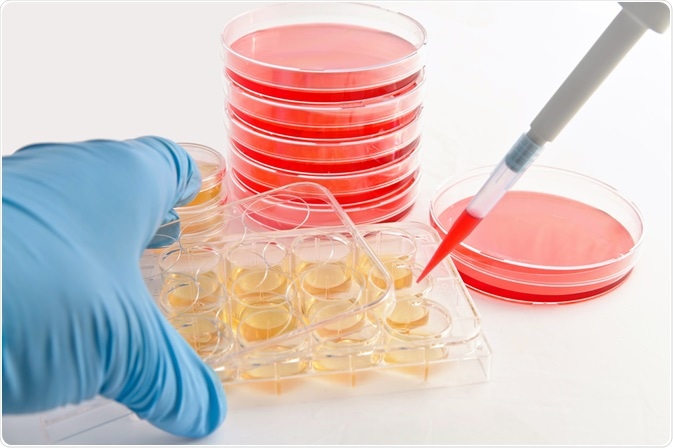Why is detecting chemosensitivity important?
Predicting how individual patients will likely respond to chemotherapy is essential in improving the efficacy of the therapeutic technique. However, it can be difficult to objectively measure how a person may react to chemotherapy, given that the chemosensitivity of cancer cells is governed by a multitude of genetic factors.

Image Credit: Jens Goepfert/Shutterstock.com
Over the decades, many studies have uncovered specific genes whose activation or inactivation can lead to chemoresistance or increased chemosensitivity.
A number of genes have been recognized as determining cancer cell sensitivity to therapeutic drugs, such as those coding for drug transporters and enzyme metabolism. Studies have also been able to reveal genes that govern the cells’ sensitivity to specific drugs.
For example, chemotherapy agent and immune system suppressant methotrexate are rendered less effective in the presence of increased activity of γ-glutamyl hydrolase and dihydrofolate reductase.
In addition, the increased activity of thymidylate synthase, metallothionein, and cytidine deaminase has been associated with resistance to the drugs 5-fluorouracil (5-FU), cisplatin, 1-β-d-arabinofuranosylcytosine, respectively. Finally, elevated activity levels of NQO1 has been related to sensitivity for mitomycin C (MMC).
While much work has been done in this field to elucidate the various genes that contribute to chemosensitivity, it cannot be determined by just a few genes. There is a wide variation in the chemosensitivity of cancer cells, and more than a handful of genes are required to fully explain this.
Investigating cell lines to extract genes involved in chemosensitivity
More recently, scientists have attempted to use genome-wide expression profile analyses to predict the chemosensitivity of cancers.
Approaches such as cDNA microarray and single nucleotide polymorphisms have been used to analyze genes associated with sensitivity to anticancer drugs. These studies have gained a certain amount of success over recent years.
In the early 2000s, a number of studies developed prediction models of anticancer efficacy, as well as validate the association of highlighted genes to chemosensitivity using panels of human cancer cell lines.
The genes that have been highlighted in these studies are those that could be developed as markers of chemosensitivity, while some of them might be directly responsible for determining the chemosensitivity of cancer cells.
Since then, studies have continued to attempt to extract specific genes as predictive markers of cancer drug efficacy by using human cancer cell lines.
Some of these studies gained particular success in elucidating numerous genes that seemingly play a role in chemosensitivity.
One in particular established a panel of 45 human cancer cell lines that were taken from tumors of the breast, liver, and stomach.
This line was known as JFCR-45. Researchers used this line to analyze the heterogeneity of chemosensitivity in the cells deriving from the three different organs. A database was established based on the analysis of the cell lines against 53 different anticancer drugs.
Gene expression was then analyzed in the cell lines using cDNA arrays. This information was added to a gene expression database.
The researchers used these two newly created databases to pull out the genes whose expression was associated with chemosensitivity. Finally, these genes were screened to select those that were able to change the cell sensitivity to anticancer drugs via an in vitro gene transfection assay.
Using cell lines to inform drug development
The results of the study showed that the genes that the team had extracted were predictive markers of drug efficacy.
A Pearson correlation analysis was applied to each type of cancer cell (from the different organs) to compare cell lines against others with the same organ background, and to remove any organ-specific genes from those flagged as potentially sensitive or resistant factors.
Numerous potential genetic markers of drug sensitivity were highlighted by this study, which, when combined with findings of previous studies, helped to validate previously extracted potential genetic markers.
The discussed study represents a general protocol for utilizing cell lines to derive chemosensitivity. Since this study, many more similar research projects have taken place to continue to expand on this work. With each study, more genes are extracted and validated.
This growing body of research is helping scientists to understand why certain people react differently to drug treatments for cancer. It is also helping them to predict who will respond better or worse, which is facilitating the tailoring of therapeutic treatments, fueling the development of personalized medicine.
Drug-resistant cancer cell lines are also being used to help researchers establish new therapeutic approaches that present higher toxicities to these cell types. A number of studies have elucidated how combination treatments, for example, can have higher levels of efficacy in drug-resistant cell lines.
The future continuation of using cell lines to derive chemosensitivity will be invaluable in developing improving drug therapies for cancer that are more patient-specific and more effective. It is likely to be particularly vital in providing treatments for those who present chemoresistance.
Sources:
- Baggerly, K. and Coombes, K. (2009). Deriving chemosensitivity from cell lines: Forensic bioinformatics and reproducible research in high-throughput biology. The Annals of Applied Statistics, 3(4), pp.1309-1334. https://arxiv.org/pdf/1010.1092.pdf
- Carmichael, J., Mitchell, J., DeGraff, W., Gamson, J., Gazdar, A., Johnson, B., Glatstein, E. and Minna, J. (1988). Chemosensitivity testing of human lung cancer cell lines using the MTT assay. British Journal of Cancer, 57(6), pp.540-547. https://www.ncbi.nlm.nih.gov/pubmed/2841961
- Chang, H., Jeung, H., Jung, J., Kim, T., Rha, S. and Chung, H. (2010). Identification of genes associated with chemosensitivity to SAHA/taxane combination treatment in taxane-resistant breast cancer cells. Breast Cancer Research and Treatment, 125(1), pp.55-63. https://www.ncbi.nlm.nih.gov/pubmed/20224928
- Nakatsu, N., Yoshida, Y. and Yamazaki, K. (2005). Chemosensitivity profile of cancer cell lines and identification of genes determining chemosensitivity by an integrated bioinformatical approach using cDNA arrays. https://mct.aacrjournals.org/content/4/3/399
Further Reading
Last Updated: Jul 12, 2022